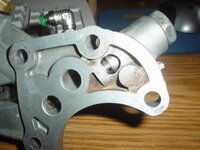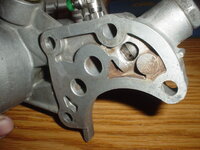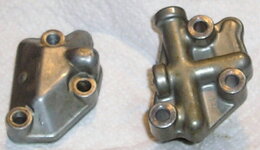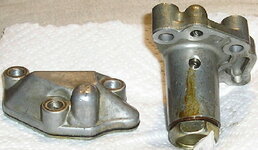turboglenn
15+ Year Contributor
- 6,375
- 111
- Nov 5, 2007
-
RIpley,
West_Virginia
So tonight i decided to hook up an oil pressure guage and see what i was really getting aside from the dash's vague readings. After fixing my down pipe flex leak and double checking the 3rd leg bolt for the oil pump, just couldn't remember if i torqued it and used loc-tite so i pulled the pan in a "better safe than sorry" approach and all was good.
Once i started it up on the fresh 5w-30 i was shocked at how much pressure i was getting... I had just put in fresh oil and it was cold and the pressure was at 60+psi at idle :WOW: it would peg past 100 and bounce the guage just by free-revving to 5500
At idle when fully warmed up, i am at about 20-25psi, then by 4k I'm steady at 60 - 70 and on up to 80 by 5k or so. Then by red-line I'm still pegging past 100 until the motor is nice and hot, but even once it's hot I'm still getting damn near 90-95psi.
I've ported the OFH to the likes of the pics I've seen on here, but I'm wondering if we can modify (shorten) or change the spring that's used in the plunger passage to change the oil pressure entirely
Here's my thought... the mirage "stub-shaft_ is what many use to do the BSE which is the main cause of this (and my cause as well) so if the mirage isn't' getting too high of pressure does it have a different spring in it's housing? or is it just a way larger hole like we get after porting?
Also, i was thinking about drilling some sort of "relief hole" in the back of the stub shaft that would just let some oil escape. My current BSE has bearings in the front side turned out of align and the oil pump side i just cut it off on the band-saw, then TIG welded the hole shut. I've got the stub shaft on the other damaged engine and wanted to see if this way wasn't as loud as the oil pump gets with the stub shaft - and it isn't
So, should i work more on the OFH, drill a relief hole, or start experimenting with the spring that's in it from Mitsubishi and trying to lower pressure...
Or is this common until you've made the hole as HUGE as you can? I wasn't sure if you needed to go "down" further to wards the piston edge, or if it needed to be wider lower so i just evenly opened it up comparable with pics from here, but it is not enough
EDIT: What about drilling a small hole i the piston of the pressure spring plunger thingy (don't knwo the real name )
)
Anyway, people have been drilling thermostats for years a "weep hole" it's called. I wonder if i took a TINY TINY drill bit and put a small hole on the edge that would line up with that groove if i could relieve just enough that it wasnt' so high and didn't jump up as fast.... it goes from the 20psi at idle right up to 60 with any blip of the throttle
Once i started it up on the fresh 5w-30 i was shocked at how much pressure i was getting... I had just put in fresh oil and it was cold and the pressure was at 60+psi at idle :WOW: it would peg past 100 and bounce the guage just by free-revving to 5500
At idle when fully warmed up, i am at about 20-25psi, then by 4k I'm steady at 60 - 70 and on up to 80 by 5k or so. Then by red-line I'm still pegging past 100 until the motor is nice and hot, but even once it's hot I'm still getting damn near 90-95psi.
I've ported the OFH to the likes of the pics I've seen on here, but I'm wondering if we can modify (shorten) or change the spring that's used in the plunger passage to change the oil pressure entirely
Here's my thought... the mirage "stub-shaft_ is what many use to do the BSE which is the main cause of this (and my cause as well) so if the mirage isn't' getting too high of pressure does it have a different spring in it's housing? or is it just a way larger hole like we get after porting?
Also, i was thinking about drilling some sort of "relief hole" in the back of the stub shaft that would just let some oil escape. My current BSE has bearings in the front side turned out of align and the oil pump side i just cut it off on the band-saw, then TIG welded the hole shut. I've got the stub shaft on the other damaged engine and wanted to see if this way wasn't as loud as the oil pump gets with the stub shaft - and it isn't

So, should i work more on the OFH, drill a relief hole, or start experimenting with the spring that's in it from Mitsubishi and trying to lower pressure...
Or is this common until you've made the hole as HUGE as you can? I wasn't sure if you needed to go "down" further to wards the piston edge, or if it needed to be wider lower so i just evenly opened it up comparable with pics from here, but it is not enough
EDIT: What about drilling a small hole i the piston of the pressure spring plunger thingy (don't knwo the real name
 )
)Anyway, people have been drilling thermostats for years a "weep hole" it's called. I wonder if i took a TINY TINY drill bit and put a small hole on the edge that would line up with that groove if i could relieve just enough that it wasnt' so high and didn't jump up as fast.... it goes from the 20psi at idle right up to 60 with any blip of the throttle



 . I'm running 10w-30. I have a BSE, but I just cut the balance shaft and plugged it because I couldn't get the oil pump apart. I stripped out the screw and just said f it.
. I'm running 10w-30. I have a BSE, but I just cut the balance shaft and plugged it because I couldn't get the oil pump apart. I stripped out the screw and just said f it.
 I may even build up and re-machining a factory bolt to not thread in as far, but that would be more time consuming as I'd have to build a new seat with the TIG and then machine it and test, machine it and test ....too much wrenching
I may even build up and re-machining a factory bolt to not thread in as far, but that would be more time consuming as I'd have to build a new seat with the TIG and then machine it and test, machine it and test ....too much wrenching 
















